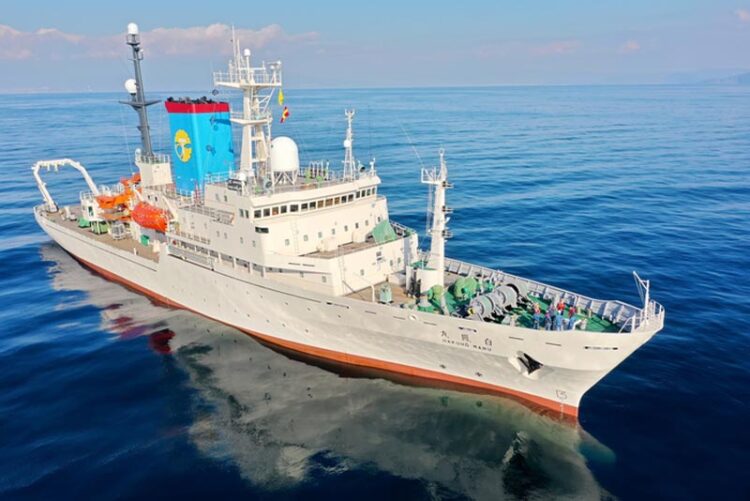Deep-sea black carbon comes from hydrothermal vents

Research Vessel Hakuho Maru conducted the observations used for this study (Photo: Youhei Yamashita)
Hydrothermal vents have been identified as a previously undiscovered source of dissolved black carbon in the oceans, furthering the understanding of the role of oceans as a carbon sink.
The ocean is one of the largest dynamic carbon sinks in the world, and is susceptible to increased carbon emissions from human activities. There are even proposals to use the ocean to sequester carbon in an effort to reduce the carbon emissions. However, much of the processes by which the ocean functions as a carbon sink are not fully understood.
Associate Professor Youhei Yamashita and grad student Yutaro Mori at Hokkaido University, along with Professor Hiroshi Ogawa at AORI, The University of Tokyo, have revealed conclusive evidence that hydrothermal vents are a previously unknown source of dissolved black carbon in the deep ocean. Their discoveries were published in the journal Science Advances.
“One of the largest carbon pools on the Earth’s surface is the dissolved organic carbon in the ocean,” explains Ogawa. “We were interested in a portion of this pool, known as dissolved black carbon (DBC), which cannot be utilized by organisms. The source of DBC in the deep sea was unknown, although hydrothermal vents were suspected to be involved.”
The researchers analyzed the distribution of DBC in the ocean basins of the North Pacific Ocean and Eastern South Pacific Ocean, and compared the data with previously reported concentrations of a helium isotope that is associated with hydrothermal vent emissions, as well as oxygen utilization in these areas.
Their findings showed that hydrothermal vents were an important source of DBC in the Pacific Ocean. This hydrothermal DBC is most likely formed due to the mixing of the hot fluids from hydrothermal vents with cold seawater, and is transported over long distances — up to thousands of kilometers away.
“Most importantly, our research indicates that the DBC from hydrothermal vents is an important source of dissolved organic carbon in the deep ocean. In terms of DBC inputs to the ocean, hydrothermal vents may contribute up to half as much DBC as that which is formed by biomass burning or fossil fuel combustion and subsequently transported via rivers or atmospheric deposition,” concluded Yamashita. Further research is required to understand exactly how DBC is formed from hydrothermal vents.
Journal: Science Advances
DOI: 10.1126/sciadv.ade3807
Method of Research: Data/statistical analysis
Subject of Research: Not applicable
Article Title: Hydrothermal-derived black carbon as a source of recalcitrant dissolved organic carbon in the ocean
Article Publication Date: 10-Feb-2023
Media Contacts
Sohail Keegan Pinto
Hokkaido University
en-press@general.hokudai.ac.jp
Office: +81-11-706-2186
@HokkaidoUni
Public Relations Office
Atmosphere and Ocean Research Institute, The University of Tokyo
kouhou@aori.u-tokyo.ac.jp
@UTokyo_AORI
All latest news from the category: Ecology, The Environment and Conservation
This complex theme deals primarily with interactions between organisms and the environmental factors that impact them, but to a greater extent between individual inanimate environmental factors.
innovations-report offers informative reports and articles on topics such as climate protection, landscape conservation, ecological systems, wildlife and nature parks and ecosystem efficiency and balance.
Newest articles

First-of-its-kind study uses remote sensing to monitor plastic debris in rivers and lakes
Remote sensing creates a cost-effective solution to monitoring plastic pollution. A first-of-its-kind study from researchers at the University of Minnesota Twin Cities shows how remote sensing can help monitor and…

Laser-based artificial neuron mimics nerve cell functions at lightning speed
With a processing speed a billion times faster than nature, chip-based laser neuron could help advance AI tasks such as pattern recognition and sequence prediction. Researchers have developed a laser-based…

Optimising the processing of plastic waste
Just one look in the yellow bin reveals a colourful jumble of different types of plastic. However, the purer and more uniform plastic waste is, the easier it is to…



